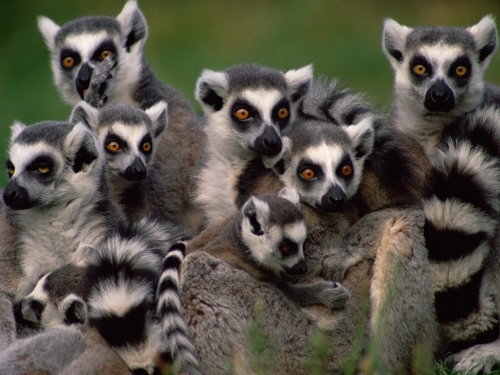The Altruistic Side of Aggressive Greed
Study explains new twist in group cooperation
26 March 2014

|
| High-rank individuals bully their group-mates to get what they want, but their contribution is key to success in conflict with other groups, according to a new study. |
KNOXVILLE - In many group-living species, high-rank individuals bully their group-mates to get what they want, but their contribution is key to success in conflict with other groups, according to a study that sheds new light on the evolutionary roots of cooperation and group conflict.
In a series of mathematical models, researchers from the National Institute for Mathematical and Biological Synthesis and the University of Oxford uncovered a mechanism for explaining how between-group conflict influences within-group cooperation and how genes for this behavior might be maintained in the population by natural selection.
Humans are unique in their innate ability and willingness to cooperate within groups ranging in size from small-scale forager bands to nations of millions of individuals. Yet, cooperation has its downsides as it can lead to what scientists call "the collective action problem," which says that if individual effort is costly and a group member can benefit from the action of group-mates, then there is an incentive to "free-ride," whereby effort is reduced or withdrawn completely. If a number of group-mates follow this logic, the public good is not produced and all group members suffer. The collective action problem also occurs in conflicts between groups: everyone benefits from the group's success, but achieving success requires costly contributions by members of the group.
The study, issued today as an open access article in the journal Nature Communications, shows that the collective action problem can be overcome in groups that have a hierarchical structure and high inequality. When within-group hierarchy and inequality are well established, high-rank individuals effectively spend their effort on competition with their peers in other groups. This competition then results in a seemingly altruistic behavior of the high-rank individuals as they make stronger effort, pay higher costs, and get smaller net benefit than their low-rank group mates who free-ride contributing nothing. The study also found that the total group effort that a group directs toward between-group conflict typically increases with the degree of hierarchy and inequality within the group.
The results are consistent with observations in nature across a range of species. The study cites chimpanzees, for example, whose high-rank males travel further into the periphery of the group during border patrols, and ring-tail lemurs and blue monkeys whose high-rank females participate more in the defense of communal feeding territories.
"As far as within-group interactions are concerned, the alpha males and females are 'bad guys' taking various resources from their group-mates. However, in between-group conflicts they become ‘good guys' and their presence and effort benefit everybody else," said Sergey Gavrilets, NIMBioS' associate director for scientific activities and the study's lead author.
While the study focuses on social instincts, those genetically-based biases affecting individual behavior in social interactions, the authors point out that human behavior is controlled not only by genes but also by other factors, including culture, the environment and rational choice. The study suggests that humans may have an innate preference for an egalitarian social structure when there is relatively little between-group conflict and, conversely, an innate preference for a hierarchical social structure when levels of between-group conflict are high. The study also predicts that humans who find themselves in a leadership position may exhibit seemingly altruistic behavior.
Citation: Gavrilets S, Fortunato L. 2014. A solution to the collective action problem in between-group conflict with within-group inequality. Nature Communications. [Open access online]
Media Coverage Highlights
TIME Magazine: Science proves it: Greed is good
#
The National Institute for Mathematical and Biological Synthesis (NIMBioS) brings together researchers from around the world to collaborate across disciplinary boundaries to investigate solutions to basic and applied problems in the life sciences. NIMBioS is supported by the National Science Foundation, the U.S. Department of Homeland Security, and the U.S. Department of Agriculture with additional support from The University of Tennessee, Knoxville.
CONTACT:
Sergey Gavrilets, NIMBioS - (865) 974-8136 sergey_at_nimbios_dot_org
Laura Fortunato, University of Oxford
Catherine Crawley, NIMBioS – (865) 974-9350 ccrawley_at_nimbios_dot_org
NIMBioS
1122 Volunteer Blvd., Suite 106
University of Tennessee
Knoxville,
TN 37996-3410
PH: (865) 974-9334
FAX: (865) 974-9461
Contact NIMBioS


